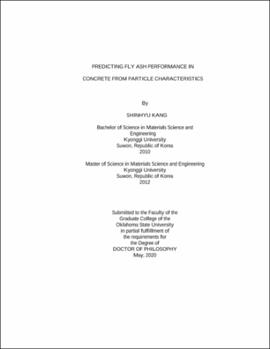| dc.contributor.advisor | Ley, M. Tyler | |
| dc.contributor.author | Kang, Shinhyu | |
| dc.date.accessioned | 2020-09-09T21:40:42Z | |
| dc.date.available | 2020-09-09T21:40:42Z | |
| dc.date.issued | 2020-05 | |
| dc.identifier.uri | https://hdl.handle.net/11244/325529 | |
| dc.description.abstract | While fly ash is widely used as supplementary cementitious material (SCM) in concrete, the demands of fly ash have been increased in producing high-performance concrete. Fly ash can contribute to the strength gain and improve the durability of concrete because of its pozzolanic and cementitious properties. Even though fly ash can be classified either Class C or Class F based on the contents of CaO according to ASTM C618, this classification has not always shown to be useful to predict performance in concrete. Because of the unpredictability of the performance of fly ash, this limits the amount of fly ash used in concrete. This study aims to develop predictive models for the compressive strength, electrical resistivity, and apparent diffusion coefficient of fly ash concrete materials. A novel approach called the Particle Model is employed to construct the predictive models for different curing dates and replacement levels. This includes investigating thousands of fly ash particles using automated scanning electron microscopy (ASEM) and classifying them into nine distinct groups based on the characteristics of the individual particle with the help of machine learning. This work has given promising linear predictive equations and important insights into how different fly ash particles contribute to the compressive strength, electrical resistivity, and apparent diffusion coefficient of concrete over time. These are an important step to build accurate predictive models for fly ash performance in concrete. In addition, the possibility of predicting the apparent diffusion coefficient using electrical resistivity was evaluated by investigating the practical relationship between two performances. The results in this dissertation could be of interest to a broad readership seeking more knowledge about the impacts of fly ash on compressive strength, electrical resistivity and apparent diffusion coefficient in concrete, usage of fly ash in concrete, and advanced technique for predicting the performances of concrete with by-products. | |
| dc.format | application/pdf | |
| dc.language | en_US | |
| dc.rights | Copyright is held by the author who has granted the Oklahoma State University Library the non-exclusive right to share this material in its institutional repository. Contact Digital Library Services at lib-dls@okstate.edu or 405-744-9161 for the permission policy on the use, reproduction or distribution of this material. | |
| dc.title | Predicting fly ash performance in concrete from particle characteristics | |
| dc.contributor.committeeMember | Russell, Bruce W. | |
| dc.contributor.committeeMember | Hartell, Julie A. | |
| dc.contributor.committeeMember | Materer, Nicholas F. | |
| osu.filename | Kang_okstate_0664D_16781.pdf | |
| osu.accesstype | Open Access | |
| dc.type.genre | Dissertation | |
| dc.type.material | Text | |
| dc.subject.keywords | apparent diffusion coefficient | |
| dc.subject.keywords | asem | |
| dc.subject.keywords | compressive strength | |
| dc.subject.keywords | fly ash | |
| dc.subject.keywords | surface electrical resistivity | |
| dc.subject.keywords | the particle model | |
| thesis.degree.discipline | Civil Engineering | |
| thesis.degree.grantor | Oklahoma State University | |
